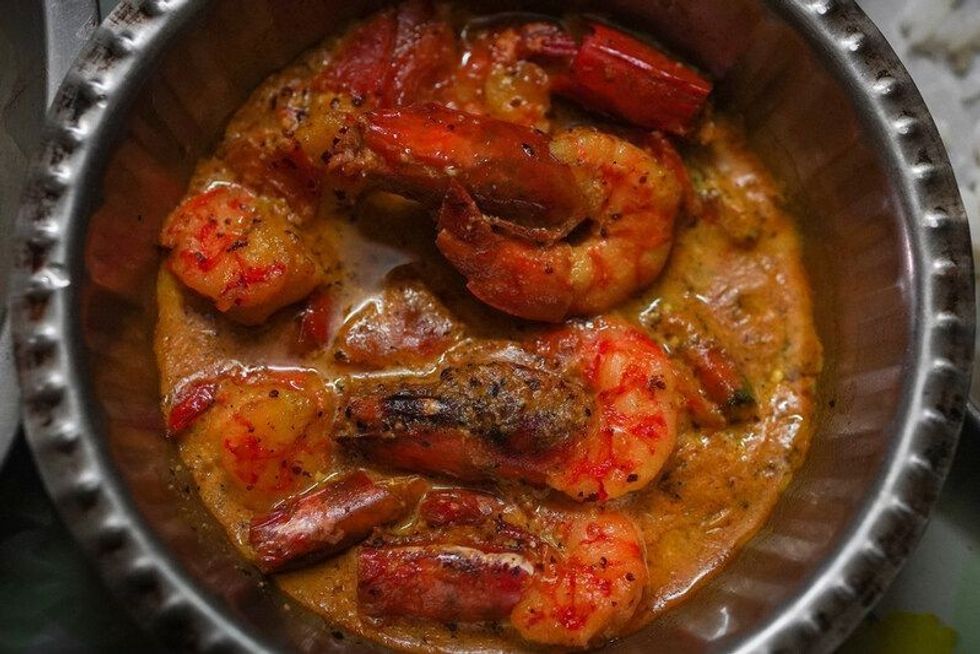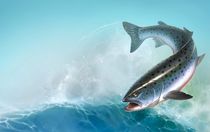121 Fin-tastic Bengali Fish Names For Kids
In West Bengal and Bangladesh, fishes form a staple part of the diet.
People here like to catch fish and enjoy it fresh after sourcing popular fish from fresh-water small rivers, paddy fields, ponds, and other water bodies. Some of the most sought-after species that fishermen seek while fishing are Bengal carp, kan magur, tilapia, common carp, Bhetki fish, and several others.
Did you know that the most popular dish in the region is Bhetki fillets served with steamed white rice and vegetables!
Common Bengali Fish Names in English
Bengal has many fish species that you are likely to be familiar with. The following list includes some of the more common Bengali fish names in English.
Threadfin Bream is found in the tropical to subtropical waters throughout the world and is excellent to eat.
Long-whiskered Catfish or ‘sperata aor’, is a well-camouflaged and highly colorful fish.
Bengal Barb is endangered in Bangladesh. It has a silver body color and the maximum length is 8 in (20 cm).
Silver Carp is a freshwater cyprinid fish found mainly in Asian countries, such as Bangladesh, China, and Indian subcontinents.
Hamilton’s Barilla belongs to the Cyprinidae family and is a tropical fish tastes superior.
Menoda Catfish are the inhabitants of rivers and ponds. It is found on the bottom of the ponds.
Dwarf Goonch is also called devil catfish, belongs to the genus Bagarius. Found largely in South Asia.
Indian Mottled Eel belonging to the family of Anguilidea is a famous fish found in the Indian and East Indies area.
Bengal Eel is a famous fish in Bengal as its mucus is used in making medicine for arthritis.
Barramundi also known as Asian sea bass, is famous in many Bengali households as it is extremely good for health.
Rainbow Minnow is originally found in North America but is popular in the region as well.
Bata is a fata also called Labeo bata. It is a native fish from the Indian and Bangladeshi areas.
Pool Barb is found in the tropical freshwater and belongs to the family of Cyprinidae.
Trout Barb also known as the Indian trout, belongs to the family of Cyprinidae and is found in the freshwater of the Bay of Bengal.
Wallago Attu is a catfish from the family of Siluridae and found in the freshwater of South and Southeast Asia.
Boga Labeo belongs to the Cyprinidae and the Actinopterygii family that is found in India, Bangladesh, Nepal, and Pakistan.
Indian River Shad or Gudusia Chapra is a fish belonging to the Clupeidae family and that is found in ponds and rivers as well.
Honey Gourami is a sweet species of gourami native that can be kept alone or with pair.
Slender Rasbora also called black-line rasbora, belongs to the Cyprinid family and is found in the rivers.
Great Snakehead or channa micropellets, is a giant mudfish that is the largest species.
Indian Salmon or rawas is one of the most loved fish delicacies in India. It can be found on the western coast.
Climbing Perch is a smart fish that are aggressive and hard to catch. Found in Southeast Asia.
Reef Cod is a greater division of several colored reef cods in the group. They belong to the Serranidae family.
Fin Bream is a white-fleshed fish that is prepared to eat in a lot of ways amongst a lot of communities.
Gray Eel-catfish are easy to catch. They have a widely spaced spine.
Bombay Duck is high on protein and they are dried to get more protein out of them. It is extremely popular.
Red Mullets are species of goatfish. It is prepared with the fish bones intact and could be found easily in a fish market.
White Mullet is a subtropical and tropical fish that belongs to the family of Mugilidae.
Tiny Fish Names In Bengali
A large number of tiny fishes are found in Bengal and Bangladesh and are eaten widely. The following is a list of some of the Bengali names for tiny fish.
Lal Chanda is an extremely small Asian fish species that is just 2 in (5.08 cm) long with blue-edged fins.
Gang Tengra is called the Ornata catfish and is 1.5 in (3.7 cm) long.
Botkoi is found in the Ganges River drainage along with ponds, and swamps throughout Bangladesh.
Bechi is found in the Choto Jamuna River. It is used to control mosquitos.
Dhal magur is a 6 in (15 cm) long fish and is native to Bangladesh.
Kani Tengra is native to the Bangladeshi Rivers.
Chuna Bele is caught in large numbers in Dakatia and Meghna Rivers in the spring season.
Nuna Baila is found in the rivers of Dakatia and Meghna rivers.
Savon Khorka is found in streams and is native to Bangladeshi waters.
Barali is native to Bangladeshi and Indian sub-continents.
Bou Mach is found in the Jamuna rivers.
Nuna Bailla is a native to Southeast Asian countries.
Gura Tengra is also called Futkibuzuri in many Bengali-speaking places.
Chep Chela is also native to the Bangladeshi and Indian rivers and streams.
Kuta Kanti is a fish found in streams that have a sandy bottom and overhanging grasses.
Kachki is popular for fishing and is found abundantly in rivers throughout Bangladesh.
Neftani is 4 in (10 cm) long and is found in rivers, ponds, and a beel throughout the Bangladeshi rivers.
Anju is found only in streams, canals, ponds, and ditches in Bangladesh.
Banspata is found in rivers and canals through the Bangladeshi waters.
Tepa is found in the Jamuna rivers along with other ponds and canals in Bangladesh.
Chola Punti is also known as Chala Punti or green barb, which is found in the Choto Jamuna River and other water sites.
Chela is a 6 in (15 cm) long fish that are found in the streams of the Meghna drainage.
Koi are found in the Choto Jamuna River and are 10 in (25 cm) long.

Large Fish Names In Bengali
Bangladesh and Bengal have several large fishes that are eaten widely. The following are some Bengali names for large fish.
Banehara is 80 in (200 cm) long, found in Somerswari, and caught from the Karnafulli Reservoir.
Gagla is found in the Bay of Bengal and caught from the river Meghna.
Baghair is found in the Ganges Basin. It is an endangered fish.
Kursha is found in rivers of Bangladeshi waters along with other south Asian countries.
Tiashol is found in beels and is known to eat the mustard plant’s flower.
Gozar is found in the Choto Jamuna River along with several swamps and beels.
Shol or snakehead murrel is 40 in (100 cm) long and is very abundantly found in the beels, ponds, and swamps throughout the South-East Asian countries.
Chital is called Clown Knifefish and is found in reservoirs and canals.
Mrigal is 39.37 in (100 cm) long and is widespread across the South-East continent.
Katol is found in the Choto Jamuna River. These are widely used in aquaculture.
Kalibaus are orange fin-Labeo and they are 36 in (90 cm) long, abundantly found in beels and rivers.
Ghora Mach is native to Bangladeshi rivers and is 36 in (90 cm) long.
Shada Ghonia is available throughout South Asian countries and is 60 in (150 cm) long.
Nandil was previously extremely abundant but has decreased due to global warming.
Bhetki or Barramundi, a widely loved fish, is 80 in (200 cm) long and found in the Bay of Bengal.
Baim or spiny eel is 36 in (90 cm) long and is found in the Choto Jamuna River.
Kuchia or mud eel is found in the Choto Jamuna River and is 28 in (70 cm) long.
Bamosh is found on the coast of the Bay of Bengal and is 40 in (100 cm) long.
Poa is also called long-finned croakers. They are found in the Bay of Bengal.
Pangas is an extremely common fish that is 120 in (300 cm) long and is found in the Choto Jamuna River along with the Ganges River.
Kharu is native to Bangladeshi rivers and is 40 in (100 cm) long. They ascend in rivers that are far above the tidal influence.
Rita is 60 in (150 cm) long and is also known as catfish.
Ayre is native to Bangladeshi rivers. They are found in the Choto Jamuna river and are also widespread.
Guizza is 60 in (150 cm) long and is known as giant river catfish, they are widespread and are also found in fields.
Most Popular Fish That Is Eaten In Bangladesh
In the Indian subcontinent, there are many fish species, but only a few are popular with people who eat seafood. Listed below are all the popular fish that are eaten in Bangladesh.
Ilish, or Hilsa, is the most popular fish that is eaten in West Bengal and Bangladesh. It is also considered the queen of fish.
Rohu, is from the carp family, mostly eaten in Bengali cuisine in West Bengal, Bangladesh, and Tamil Nadu.
Katla, found in the freshwater in South-Asian countries, is also enriched with vitamins and proteins.
Tangra, a small-sized catfish, is preferred by people of West Bengal and Bangladesh. It is easy to prepare and good for health.
Tilapia is the healthiest form of fish that has a lot of essential vitamins and minerals in it for human consumption.
Bhetki, also called Barramundi, is not your everyday served fish. It is eaten and served on specific occasions.
Pomfret is the healthiest fish for your skin, hair, and eyesight. It is specifically famous in Bengal states.
Chingri, prawns that are preferred widely by people of Bengal and Bangladesh. Many curries are made with it.
Bhola is one of the biggest fishes found by fishermen in the rivers. It is commonly known as the Asian sea bass.
Pabda is an excellent source of omega-3 fatty acids along with vitamins and minerals. It is a freshwater found fish,
Aar is found in the western rivers in southern India and is high in calcium and proteins.
Chitol, known as Indian featherback, is found in the Brahmaputra river mainly in Bangladesh, India, Nepal, and Pakistan.
Shorputi is a silver barb fish, a rustic flavored curry is prepared with it.
Pulasa is a fresh rainy water rare fish that people book a year in advance.
Kajuli is a species of catfish. It is tender and immensely flavorsome.
Tor Tor is a mahseer fish that is commonly found in fast-flowing streams and rivers.
Rani also called the pink perch fish, is high in docosahexaenoic acid, highest in any freshwater fish.
Karimeen is a sweet and salty flavored fish that is extremely famous among sea-food lovers in Kerela.
Parshe is a freshwater fish that is quite famous in Bengal. It is sweet with its lean and delicate texture.
Gurjali or the Indian Salmon is a protein-rich fish that helps to maintain a healthy metabolism.
Wallago Attu also known as the helicopter catfish, is a freshwater catfish, native to South-East Asian countries.
Mourola is the Indian Anchovies, small-sized, with a different taste, and pairs well with mustard paste.
Trout is extremely good for health with a high amount of protein, niacin, vitamin B12, and omega-3 fatty acids.
More Bengali Cuisine Names Using Seafood
Fish cutlets and fish fry are staples of Bengali cuisine. We have compiled a list of many more Bengali dishes, including not just fish, but prawns and crabs as well.
Fish Kabiraji is fried fish fillets that are a savory food eaten widely during evening tea in Bengali-spoken cities and countries.
Bengali Doi Maach is perfect for lunch as it is made by marinating fish and preparing a yogurt-based curry to go with white rice.
Sorsebata Ilish Maach, prepared in mustard oil with pungent flavors.
Fish Biryani, a meal in itself, prepared with butter, bay leaf, mustard oil, and white rice. It is a favorite of many belonging to Bengali culture.
Machcher Jhol is a simple curry that is prepared by catching fresh fish in mustard oil.
Daab Chingri is a wholesome mix of shrimps with different Bengali flavors and is wrapped in coconut.
Bhetki Paturi is cooked wrapped in leaf parcels, after getting marinated in mustard oil, turmeric, and salt. It is eaten on white rice.
Chingri Malaikari is a curry that is made with king and tiger prawns combined with coconut milk and spices. It was extremely popular during British rule in India.
Chingri Macher Kalia is a Bengali curry made with either shrimp or prawns by marinating it. Potatoes are also served with it.
Pomfret Mache Jhal is a tomato-based curry made with nigella seeds, garlic, and green chilies. It takes less than half an hour to prepare.
Kakrar Jhal is a seafood crab curry that is famous in Bengali culture. Served with potatoes and crab.
Katla Kalia is a very famous dish in Bengali cuisine, made with fresh-caught fatty fishes by tempering the oil with bay leaf, cumin seeds, and cinnamon sticks.
Panta Ilish is popular comfort food, famous for the Pohela Boishakh festival, ‘Bengali new year’, prepared with leftover rice and fried hilsa fish.
Rui Posto a famous dish of Ghoti Bari, is also prepared in sweet water after the marinating of fish.
Puti Macher Tok is a regional Bengali fish curry in West Bengal prepared simply with different Indian spices.
Chingri Posto is prepared in a poppy seed paste, with prawns and potatoes.
Shorputi Jhal is an easy dish to prepare in 15 minutes. Made with nigella seeds, mustard oil, and a couple of green chilies.
Shorshe Bhapa Mach is a famous dish prepared during the monsoon months of Bengal with Hilsa fish that is regarded as the queen of fish.
Macher Muro Diye Moong Dal is a dish only prepared on some occasions with moong dal and the head of the fish.
Chital Maacher Muitha is a flavored fish curry made with chital fish nuggets and severed with a spicy onion tomato-based gravy.
Muri Ghonto is the most authentic fish curry famous in West Bengal and Bangladesh with crispy fish heads, potatoes, and rice.
Koi Macher Jhal is a traditional Bengali curry, popular in Bengal and Bangladesh due to its simplicity.
Tangra Macher Jhal is a catfish fried with potatoes, tomatoes, onion, and garlic along with mustard oil, seeds, and nigella seeds. It is a favorite of many.
We Want Your Photos!
More for You
Bachelor of Science specializing in Human Anatomy

Joan AgieBachelor of Science specializing in Human Anatomy
With 3+ years of research and content writing experience across several niches, especially on education, technology, and business topics. Joan holds a Bachelor’s degree in Human Anatomy from the Federal University of Technology, Akure, Nigeria, and has worked as a researcher and writer for organizations across Nigeria, the US, the UK, and Germany. Joan enjoys meditation, watching movies, and learning new languages in her free time.
Bachelor of Science specializing in Microbiology, Masters of Science specializing in Biotechnology

Pratiti NathBachelor of Science specializing in Microbiology, Masters of Science specializing in Biotechnology
A Master's in Biotechnology from Presidency University and a Bachelor's in Microbiology from Calcutta University. Pratiti holds expertise in writing science and healthcare articles, and their inputs and feedback help writers create insightful content. They have interests in heritage, history, and climate change issues and have written articles for various websites across multiple subjects. Their experience also includes working with eco-friendly startups and climate-related NGOs.
Disclaimer
1) Kidadl is independent and to make our service free to you the reader we are supported by advertising. We hope you love our recommendations for products and services! What we suggest is selected independently by the Kidadl team. If you purchase using the Buy Now button we may earn a small commission. This does not influence our choices. Prices are correct and items are available at the time the article was published but we cannot guarantee that on the time of reading. Please note that Kidadl is a participant in the Amazon Services LLC Associates Program, an affiliate advertising program designed to provide a means for sites to earn advertising fees by advertising and linking to Amazon. We also link to other websites, but are not responsible for their content.
2) At Kidadl, we strive to recommend the very best activities and events. We will always aim to give you accurate information at the date of publication - however, information does change, so it’s important you do your own research, double-check and make the decision that is right for your family. We recognise that not all activities and ideas are appropriate for all children and families or in all circumstances. Our recommended activities are based on age but these are a guide. We recommend that these ideas are used as inspiration, that ideas are undertaken with appropriate adult supervision, and that each adult uses their own discretion and knowledge of their children to consider the safety and suitability. Kidadl cannot accept liability for the execution of these ideas, and parental supervision is advised at all times, as safety is paramount. Anyone using the information provided by Kidadl does so at their own risk and we can not accept liability if things go wrong.
3) Because we are an educational resource, we have quotes and facts about a range of historical and modern figures. We do not endorse the actions of or rhetoric of all the people included in these collections, but we think they are important for growing minds to learn about under the guidance of parents or guardians.







